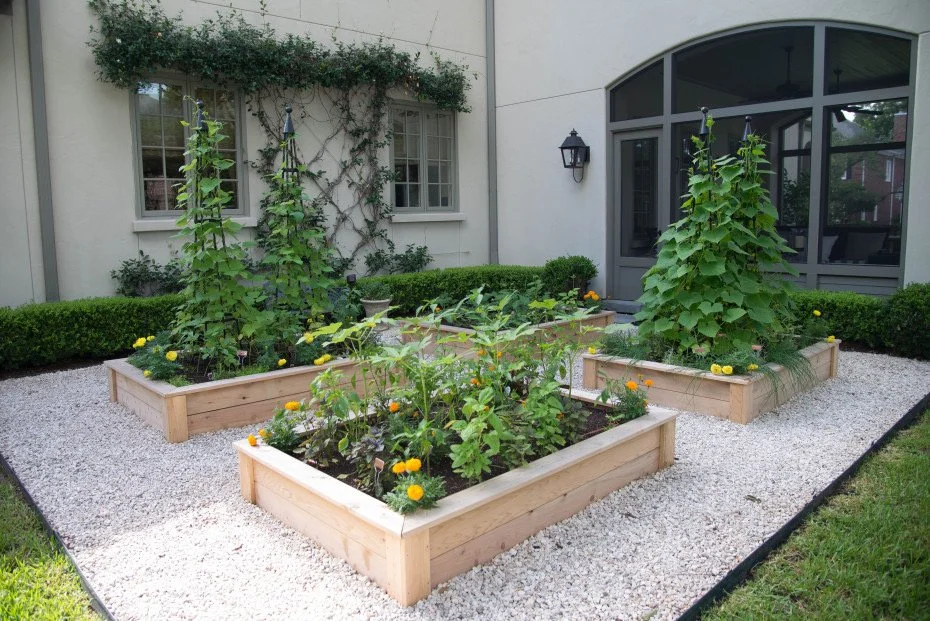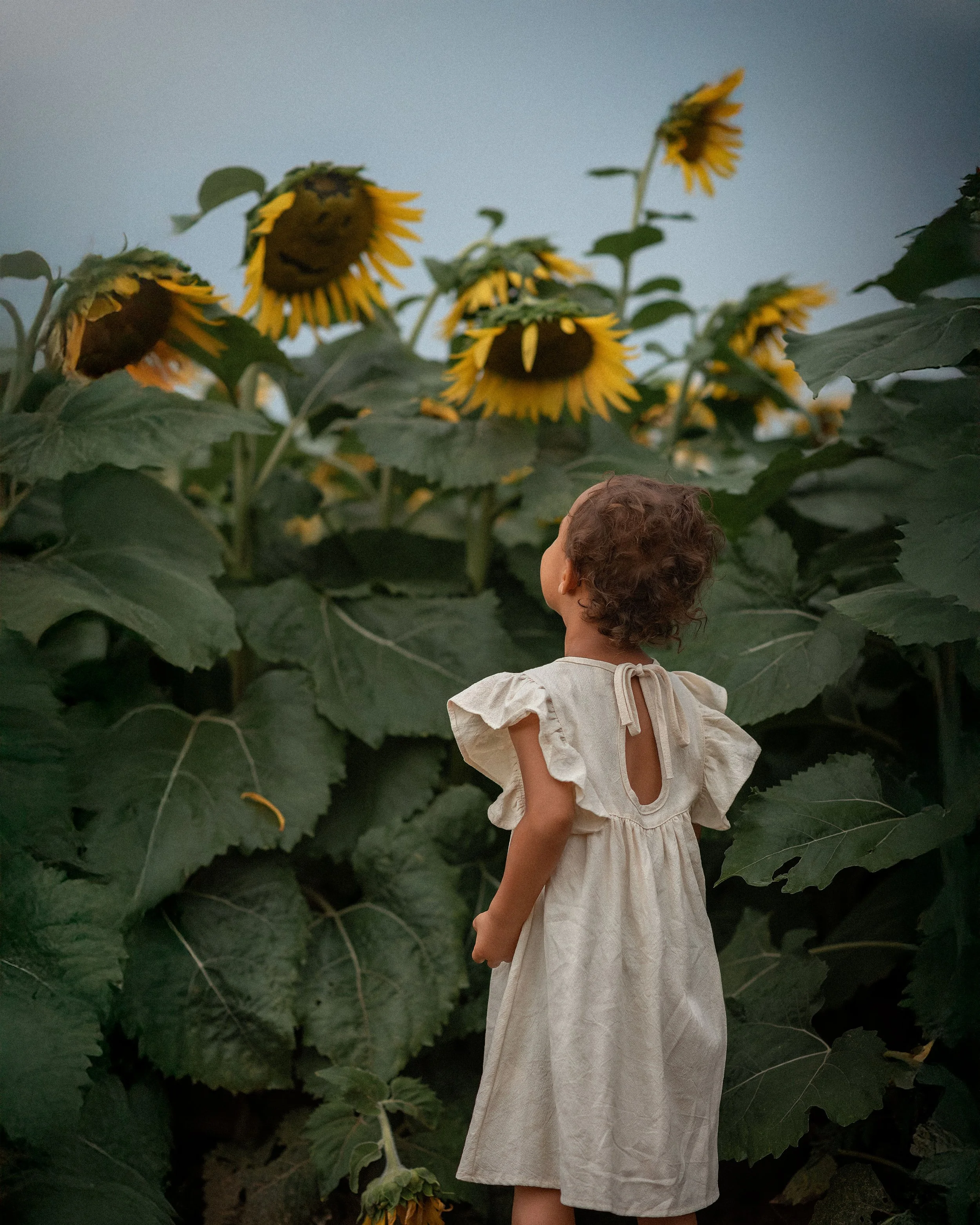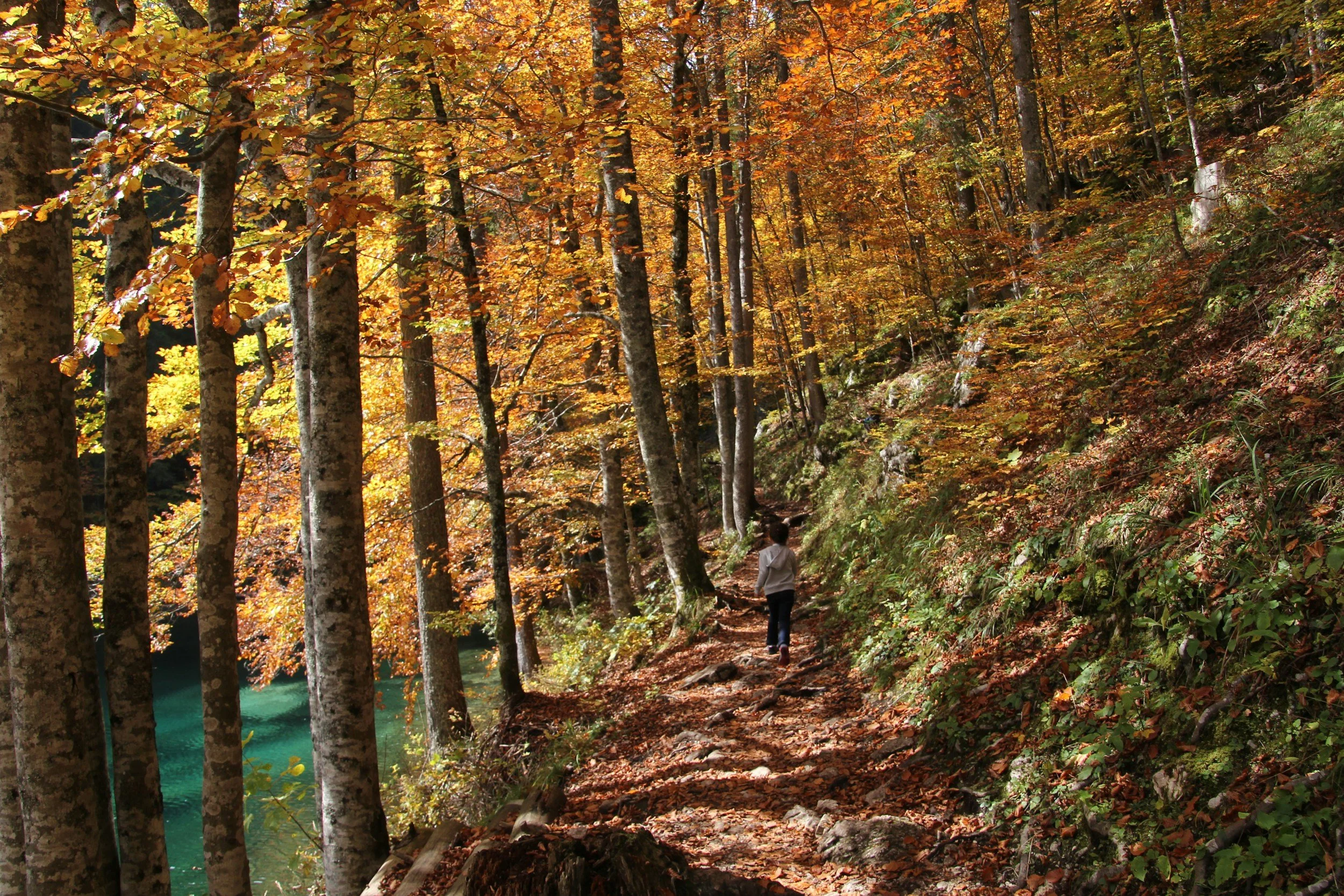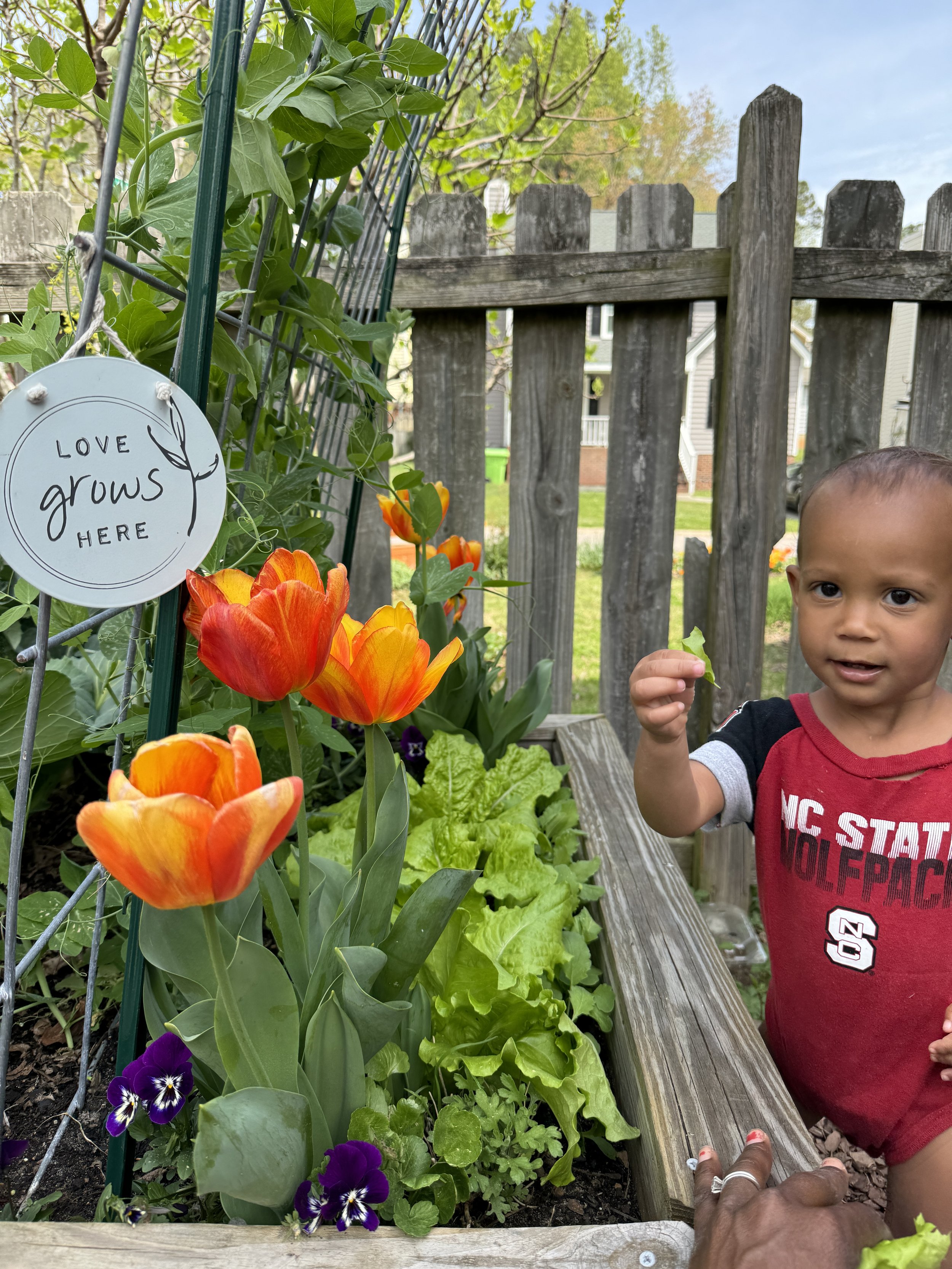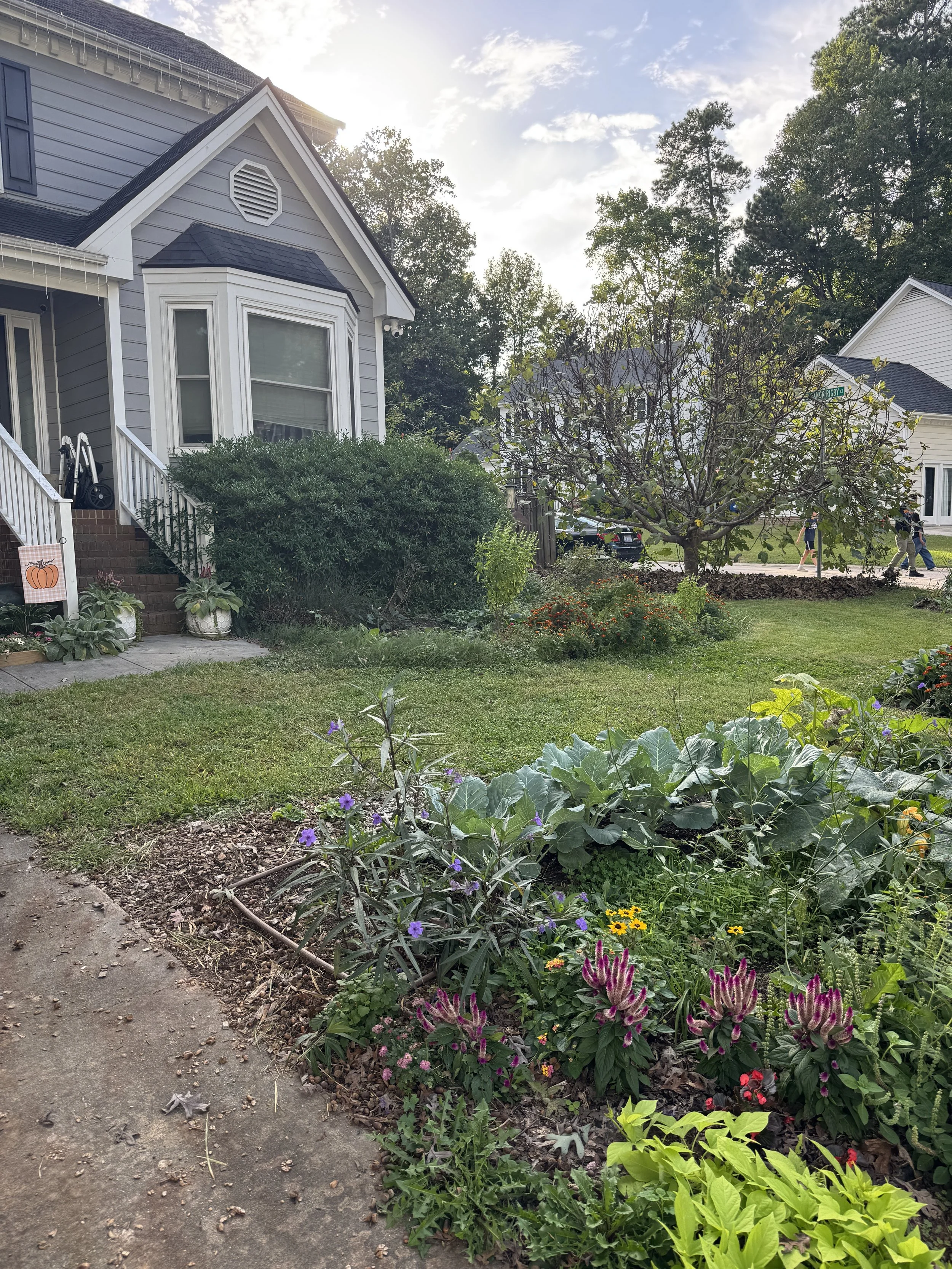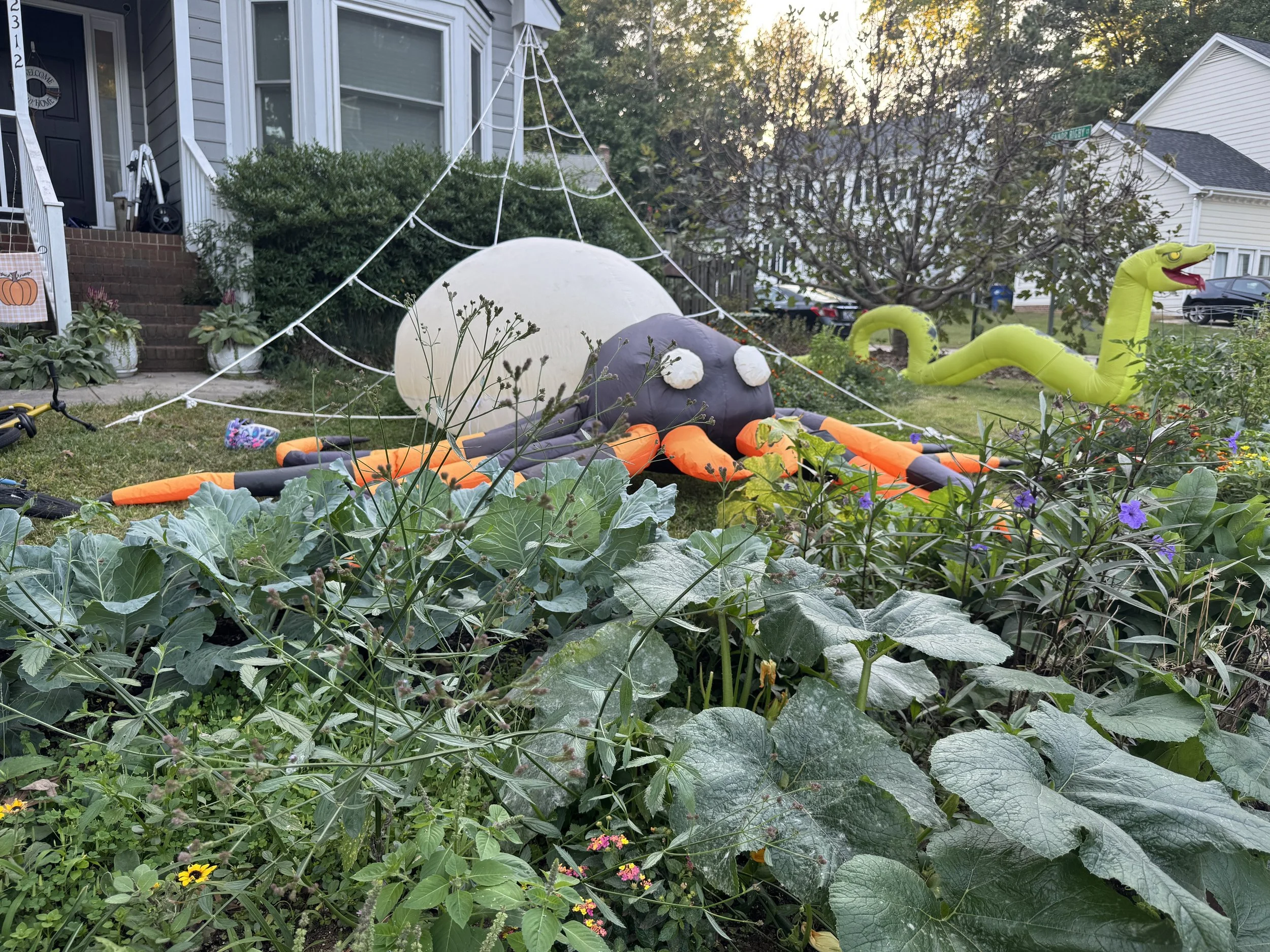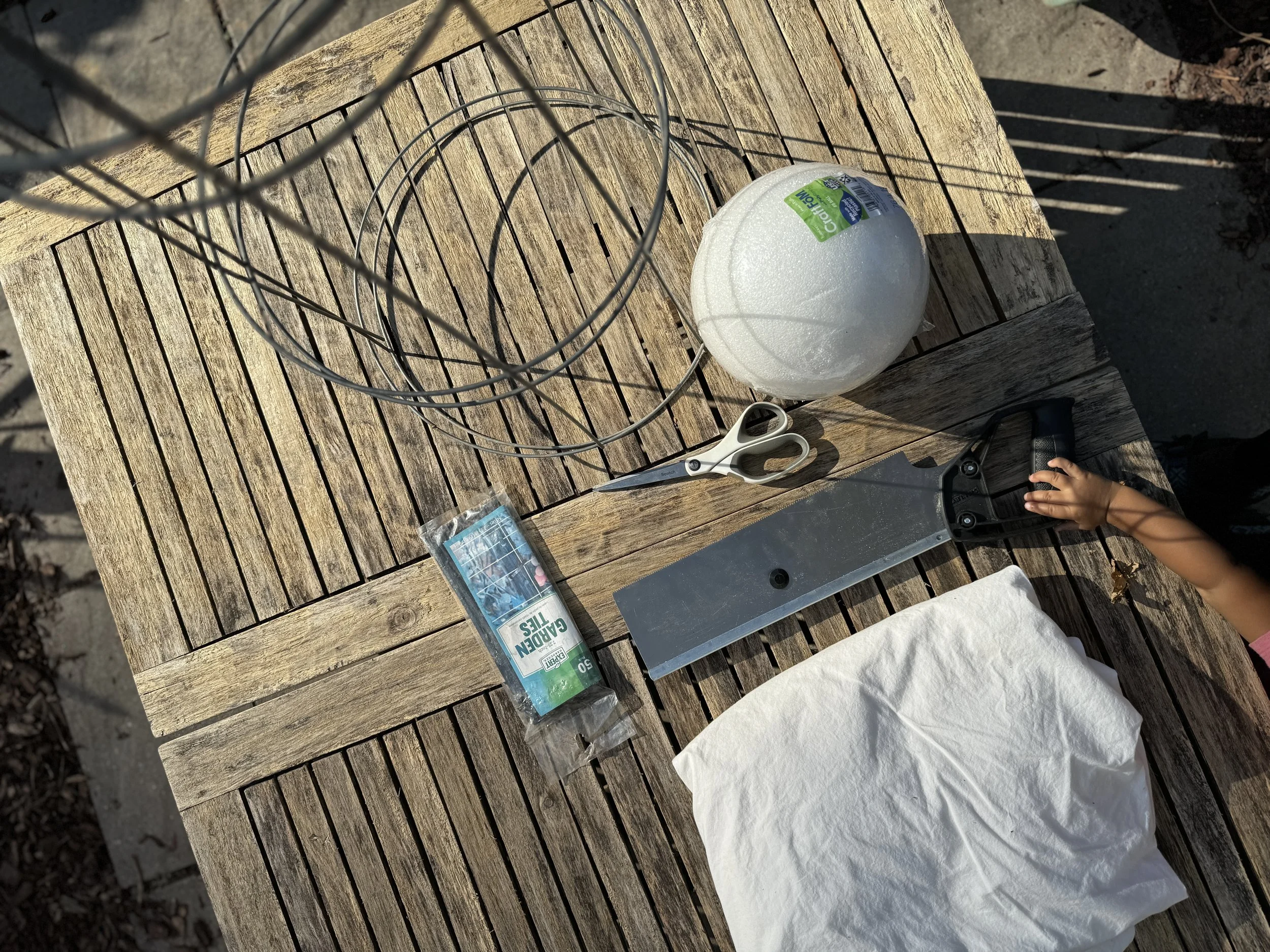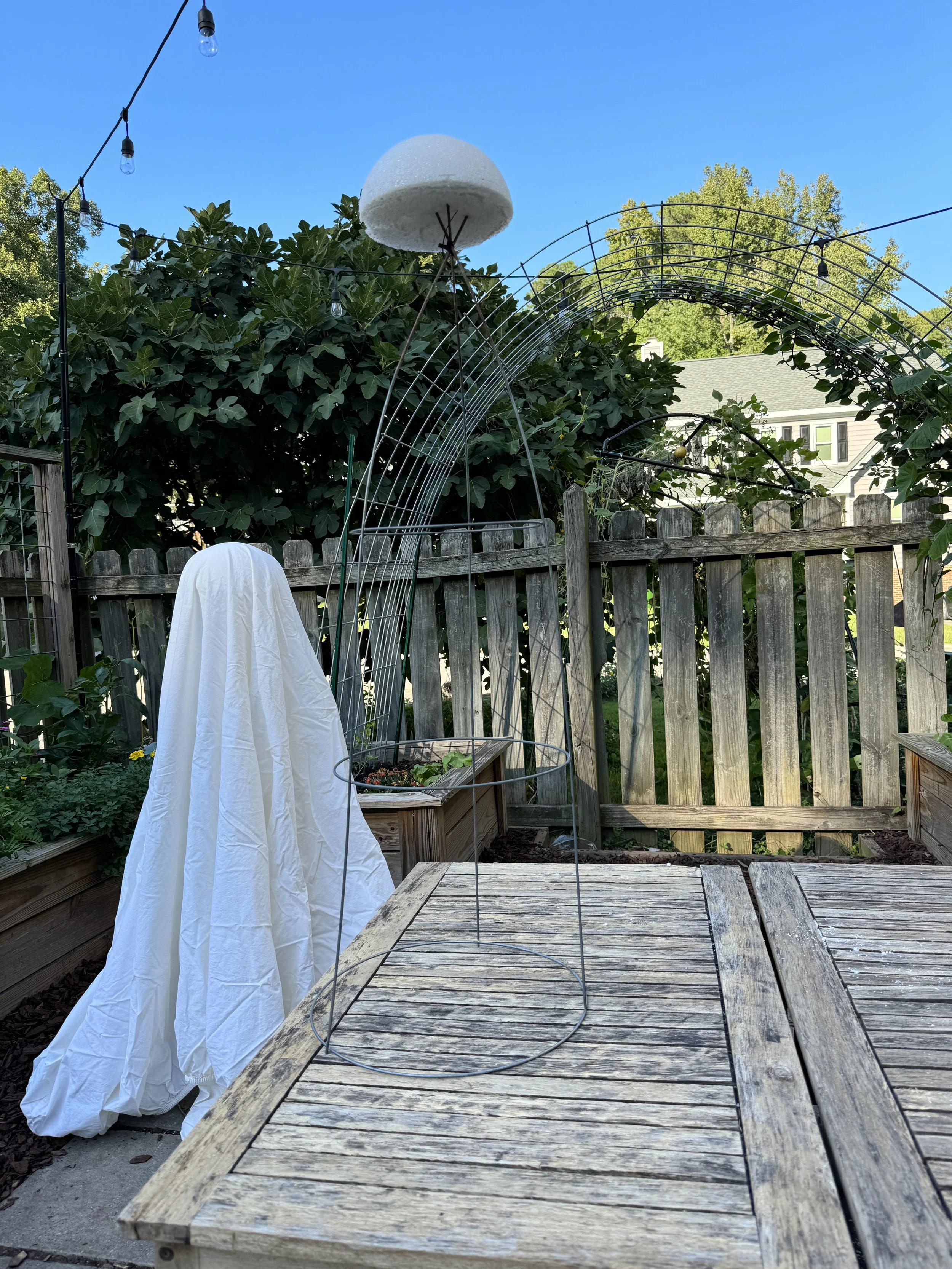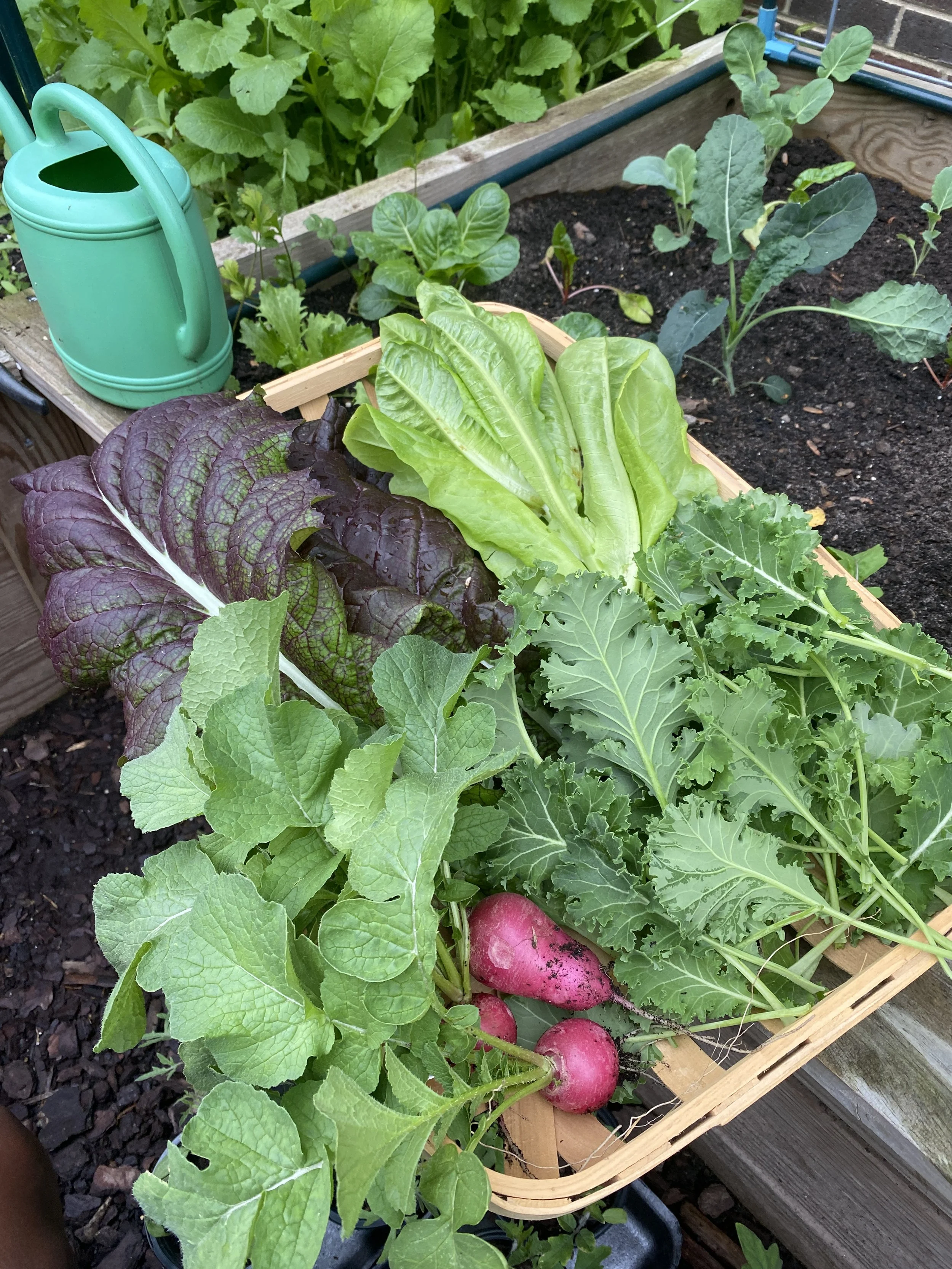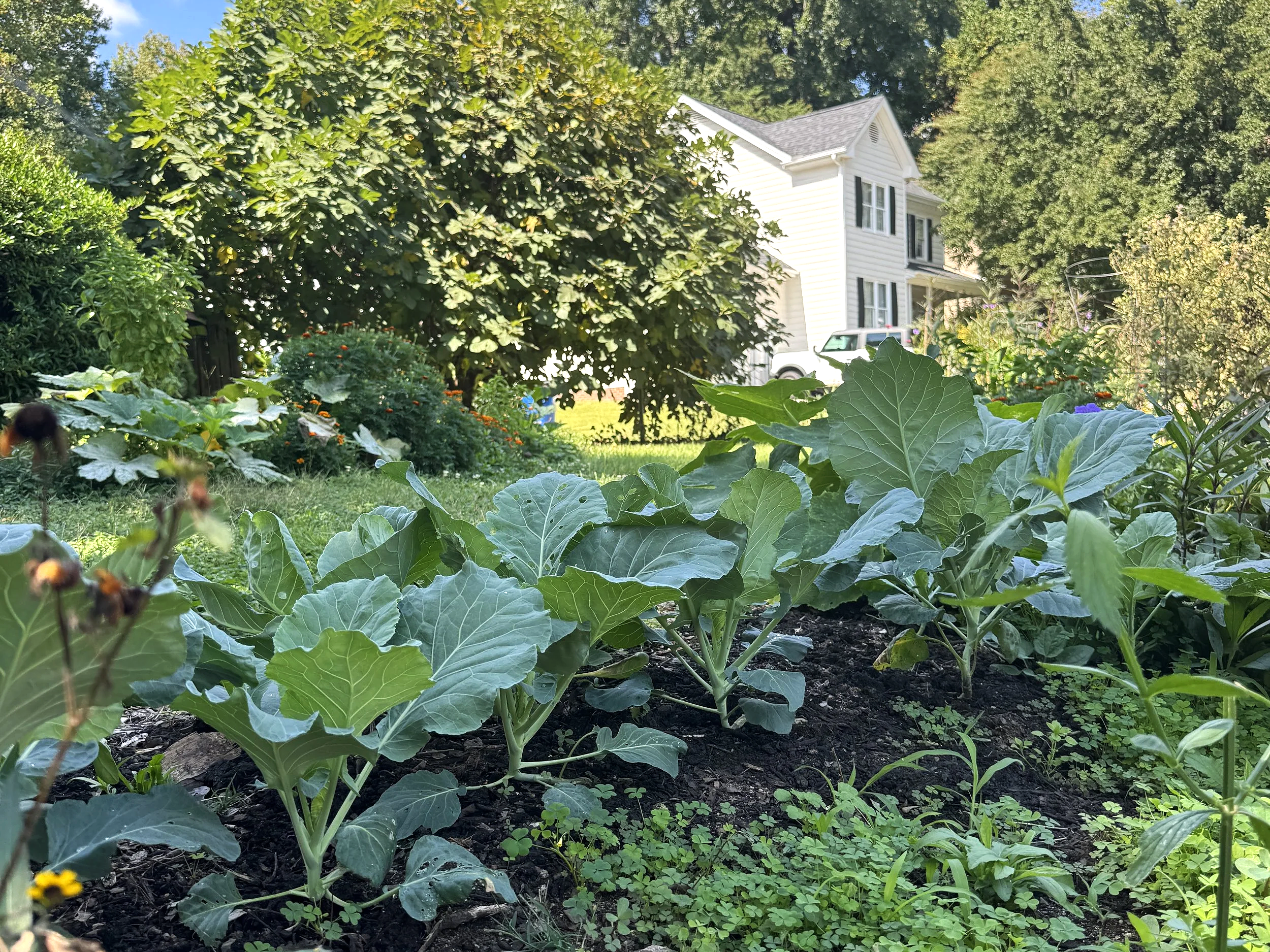Where gardening, homesteading, family, and simple sustainable living all come together.
How to Reuse Leftover Pumpkins as Natural Bird Feeders
Perfect for Migrating Birds, Backyard Wildlife & Your Garden
Fall is one of my favorite seasons on the homestead—cooler air, crisp mornings, and of course… pumpkins everywhere. Once Halloween and Thanksgiving pass, many families toss their pumpkins without a second thought. But if you’re anything like our crew, you know that a leftover pumpkin is not trash—it’s an opportunity for creativity, sustainability, and a little backyard magic.
This week, my 3-year-old and I turned our leftover pumpkins into natural pumpkin bird feeders, and it ended up being one of the sweetest moments of the season. We even filmed the whole process to share on YouTube next week, because this is exactly the kind of simple, joyful activity I love encouraging other families to try.
Not only does this project help reduce waste, but it supports migrating birds, enriches your garden soil, and offers a hands-on nature activity that little ones absolutely adore.
Here’s everything you need to know to create your own DIY pumpkin bird feeder this fall.
Why Make a Pumpkin Bird Feeder?
If you’ve never made a natural bird feeder before, prepare for something beautiful. Using pumpkins as feeders is more than a craft—it’s a tiny ecosystem moment. Here’s why this project is worth your time:
1. It Supports Migrating Birds
Autumn and early winter are critical for birds migrating through North Carolina and the Southeast. As temperatures drop, natural food sources become scarce. By offering nutrient-rich seeds in a feeder, you help birds build the energy they need to travel long distances.
2. It’s Completely Biodegradable
Unlike plastic or metal feeders, pumpkin feeders return to the earth naturally. When the pumpkin breaks down, you can compost it or simply let it decompose into the soil, adding organic matter back into your garden beds.
3. It’s a Fun, Hands-On Nature Activity for Kids
Toddlers and preschoolers love sensory-rich projects. Scooping out pumpkin seeds, tying yarn, adding birdseed—it’s all tactile, engaging, and easy to do together. My 3-year-old was SO proud to see our finished feeder hanging in the tree (and even more excited when the first chickadee found it!).
4. It Benefits Your Garden
Birds don’t just bring joy—they bring pest control. Attracting feathered friends improves your garden’s health year-round, especially as overwintering insects start to settle in.
What You Need (Most of It You Already Have!)
The best part of this pumpkin bird feeder DIY is that everything is simple, accessible, and often already in your home.
Leftover pumpkin (we used half of a medium pumpkin)
Knife (for an adult to cut the pumpkin safely)
Spoon or scoop for removing seeds
Bowl to collect seeds for roasting
Wooden dowel rods
Yarn, jute twine, or natural string for hanging
Birdseed mix
Tree branch to hang your feeder from
How to Make a DIY Pumpkin Bird Feeder (Step-by-Step Guide)
1. Prepare Your Pumpkin
Choose a pumpkin that’s still firm and not moldy. Cut it in half horizontally, creating a bowl-like shape. You want the bottom portion deep enough to hold birdseed without spilling.
2. Scoop Out the Inside
Let your kids help scoop—yes, it gets messy, but that’s the best part! Save the seeds in a bowl, clean them, and roast them later for a no-waste treat.
3. Insert Wooden Dowel Rods
Use a skewer or screwdriver to poke holes through each side of the pumpkin creating an “X” or cross. Slide wooden dowel rods through so they create little crossbars through the pumpkin. This supports the pumpkin when hung in the tree.
4. Attach the Hanging Strings
Cut four equal lengths of yarn or jute. Use a small knife to poke a hole near the top edge of the pumpkin, then tie each string securely to the dowel rods. Bring all four strings together and knot them at the top to create a hanger.
5. Fill with Birdseed
Pour in your favorite seed blend. Black oil sunflower seeds, millet, and cracked corn are great for local birds.
6. Hang It in a Safe Spot
Choose a tree branch high enough to avoid cats or other predators. Make sure it’s sturdy and visible so you and your kids can watch birds enjoy their treat.
Why Birds Love Pumpkin Feeders
Pumpkins are naturally appealing to birds:
They provide a stable, shallow bowl shape
The edges give birds a natural place to grip
Some species may even peck at the pumpkin flesh for moisture and nutrients
Plus, pumpkin feeders blend beautifully into the landscape—no need for bright plastic or store-bought materials.
Pumpkin Feeders and Garden Ecology
When the pumpkin begins to break down (usually after about a week or two), you can simply compost it or bury it in a garden bed. Earthworms, soil microbes, and fungi will break it down and turn it into organic matter that boosts soil structure and fertility.
Birds also contribute to garden health by:
Eating overwintering pests
Spreading seeds
Providing natural aeration as they scratch and forage
Everything works in a cycle—and this little feeder plays a surprisingly meaningful part.
A Beautiful Activity to Share With Your Kids
One of my favorite parts of homesteading is weaving small, meaningful rituals into our everyday life. This simple project gave my daughter and me a moment to slow down, talk about the birds migrating overhead, and learn about how our actions can help care for the world around us.
Crafts like this help kids develop:
Fine motor skills
Sensory exploration
Environmental awareness
Empathy for wildlife
A sense of responsibility and pride
And honestly? It’s just plain joyful.
(If you want to see our version step-by-step, keep an eye out for the YouTube video dropping this week!)
Final Thoughts: A Simple, Eco-Friendly Way to Reuse Leftover Pumpkins
Reusing leftover pumpkins as natural bird feeders is one of those perfect fall activities—eco-friendly, budget-friendly, kid-friendly, and beneficial to the garden and local wildlife. If you’re looking for a fun, meaningful project to do with your kids this season, this is it.
Hang one up, watch the birds swoop in, and enjoy a moment of nature-filled magic right in your backyard.
Packing the Perfect Fall Nature Adventure Backpack
There’s something truly magical about fall hikes in North Carolina — the crisp air, the crunch of leaves under little boots, and the explosion of color that paints our favorite nature trails.
A Gear Guide for Cooler, Leaf-Covered Trails
There’s something truly magical about fall hikes in North Carolina — the crisp air, the crunch of leaves under little boots, and the explosion of color that paints our favorite nature trails. But with that beauty comes a bit of planning. The temperatures can change quickly, trails can get damp, and those tiny explorers (and let’s be honest — us parents too!) can get hungry, chilly, or muddy fast.
If you’re joining us for our free monthly Nature Sprouts Adventure Club hike this weekend, or simply planning your own fall nature day with the kids, this guide will help you pack the perfect fall adventure backpack — so you can focus on fun and connection, not forgotten mittens.
Why Fall Hiking is Special (and Needs a Little Extra Prep)
Fall is one of the most comfortable times to hike in the Triangle area — fewer bugs, fewer crowds, and endless opportunities for leaf collecting, animal tracking, and puddle jumping. But autumn weather can be tricky. Mornings often start cool and damp, then warm up by mid-day. That means your backpack needs to work double-time — carrying layers, snacks, and supplies to keep everyone happy on the trail.
The right preparation turns a good hike into a great one — filled with learning, laughter, and connection with the natural world.
What to Pack in Your Fall Nature Adventure Backpack
Here’s a tried-and-true list of fall hiking essentials for families — all tested by our Nature Sprouts families who love to play, explore, and learn outdoors.
1. Layered Clothing Essentials
Fall weather changes fast! Pack:
A lightweight, long-sleeve base layer for everyone
A fleece or sweatshirt for warmth
A waterproof or wind-resistant outer layer
Extra socks (wet leaves happen!)
A warm hat or headband — even for kids who say they “don’t need one”
Pro tip: Pack an extra plastic grocery bag for storing muddy clothes or wet shoes after the hike.
2. Hydration + Healthy Snacks
Even in cooler weather, kids (and adults) need plenty of water.
Pack:
Refillable water bottles or small hydration packs
A thermos of warm herbal tea or apple cider for post-hike sipping
Trail-friendly snacks like:
Apple slices + nut butter
Mini muffins
Granola bars
Roasted chickpeas
Dried fruit
Avoid high-sugar snacks — they spike energy, then crash mid-trail.
3. Nature Tools for Curious Explorers
Encourage hands-on discovery! Bring along:
A small magnifying glass or loupe
Field journal or nature observation cards
Pencil or crayons for sketching finds
A reusable bag or box for “nature treasures” (like fallen leaves or pinecones)
If your child is part of the Nature Sprouts Adventure Club, this is a perfect time to bring their Adventure Passport or Field Notes booklet to record what they see.
4. Safety + Comfort Items
A well-packed first aid kit can save the day. Include:
Band-aids, antiseptic wipes, and tweezers
Sunscreen + bug spray (yes, even in fall!)
Hand sanitizer or wipes
A whistle for kids to carry on a lanyard (great safety skill practice!)
Small pack of tissues or biodegradable wipes
Compact blanket or sit-mat for snack breaks
5. Tech + Navigation (Optional but Helpful)
If you’re venturing on a new trail:
Download offline maps using AllTrails or Google Maps before you go
Carry a portable phone charger
Take a photo of the trailhead map before heading out
Bonus: Bring a small camera so kids can practice nature photography
6. Fun Add-Ons for Fall Adventures
These little extras make the experience magical:
Binoculars for spotting birds or squirrels
Mini magnifier jars for safe insect observation
Reusable hand warmers for chilly fingers
Lightweight picnic blanket for spontaneous snack breaks
Small reusable tote for collecting litter — teaching “leave no trace” habits early
Family Fall Hike Packing Checklist
Want to keep it simple? Here’s your one-look list to check before you head out:
✅ Weather-appropriate layered clothing
✅ Water + snacks
✅ First aid + hand wipes
✅ Nature tools (journal, magnifier, bag)
✅ Blanket or mat
✅ Extra socks + plastic bag for wet gear
✅ Phone/camera + trail map
✅ Trash bag for cleanup
Local Tip: Where to Go for Fall Family Hikes in the Triangle
Some of our favorite kid-friendly fall trails include:
Durant Nature Preserve (Raleigh): Wide paths, shady woods, and a beautiful lake loop.
Annie Louise Wilkerson Nature Preserve (Raleigh): Perfect for younger explorers with short, engaging loops.
Eno River State Park (Durham): Vibrant foliage and shallow creek crossings for leaf boat races.
Bond Park (Cary): Great mix of forest and open spaces, plus playgrounds for post-hike playtime.
Building Connection Through Nature
When families hike together, kids learn more than plant names or trail safety. They learn patience, confidence, and curiosity — the heart of what we nurture at Nature Sprouts Adventure Club. Every crunchy leaf, bird call, and muddy handprint is a moment of growth and memory-making.
So, grab that backpack, check off your list, and come explore with us!
Our Free Monthly Family Hike is happening this weekend — and we’d love for you to join us. You’ll meet other nature-loving families, learn fun outdoor skills, and soak in the last of fall’s golden glow before winter sets in.
RSVP today through our website or via our link in bio on Instagram @nature_sprouts_adventure_club to save your spot.
See you (and your perfectly packed backpack!) on the trail.
Planning & Preparing – Know Your Climate Before You Grow
Before you ever drop a seed into the soil, there’s one step that separates successful gardeners from frustrated beginners: understanding your climate.
Before you ever drop a seed into the soil, there’s one step that separates successful gardeners from frustrated beginners: understanding your climate.
At My Carolina Homestead, we believe that gardening isn’t about copying what works on social media — it’s about learning what works where you live. Your climate determines everything: when you plant, what you plant, and how you care for it. Whether you’re growing on a balcony, a backyard, or a full-sized homestead, knowing your local conditions helps you garden smarter, not harder.
Why Knowing Your Climate Matters
Think of your garden like a relationship — if you don’t take time to understand it, it probably won’t thrive.
Your climate zone, microclimate, and seasonal weather patterns dictate how plants grow. Knowing these key details allows you to choose the right plants, plant them at the right time, and give them the care they need to flourish.
Here in Zone 8a (the Piedmont region of North Carolina), for example, we enjoy long growing seasons, mild winters, and hot, humid summers. That means we can grow cool-season crops like lettuce and broccoli in early spring and fall, and heat-lovers like tomatoes, peppers, and okra in summer.
Without understanding that rhythm, many beginners end up planting too early, too late, or choosing varieties that can’t handle our heat or humidity.
Step 1: Find Your USDA Plant Hardiness Zone
Your USDA Hardiness Zone is the starting point for understanding your climate. This map divides North America into zones based on the average annual minimum winter temperature.
Here’s how to find yours:
Go to planthardiness.ars.usda.gov.
Enter your ZIP code.
Note your zone number (for example, Zone 8a = 10–15°F minimum winter temps).
Once you know your zone, you can choose plants that are hardy for your area. Many seed packets and plant tags include this information, helping you make smarter choices from the start. That’s all this little number tells you as a home gardener, but it’s still pretty important to know!
Step 2: Understand Your Microclimates
Even within the same zone, no two gardens are identical. Microclimates are small pockets of varying temperature, light, and moisture — like the shady side of your house, a sunny patio, or a low spot where water collects.
Here at My Carolina Homestead, we encourage new gardeners to observe their space for at least a week before planting:
Watch where the sun hits morning and afternoon.
Notice which areas stay damp after rain.
Pay attention to wind direction and frost pockets.
Knowing your microclimates helps you place plants where they’ll thrive — like putting heat-loving herbs near a south-facing wall or tucking lettuces into cooler, shaded corners.
Step 3: Track Your Frost Dates
Your first and last frost dates tell you when it’s safe to plant tender crops and when to expect your growing season to end.
In Zone 8a, our average last frost is around mid-March, and our first frost usually comes in early November. That gives us a long window to grow spring, summer, and even fall gardens.
Mark these dates on your gardening calendar. When in doubt, plant in succession — sowing seeds every few weeks — to stretch your harvest and hedge against weather surprises.
Step 4: Learn Your Soil and Rain Patterns
Your soil and rainfall go hand in hand with climate. North Carolina’s red clay soil, for instance, is rich in nutrients but can be heavy and slow-draining. Understanding that helps you know whether to amend with compost, raise your beds, or add mulch to retain moisture during hot spells.
Here’s how to start:
Test your soil. You can send samples to the North Carolina Department of Agriculture for free most of the year.
Track rainfall. Most plants need about 1 inch of water per week. Use a rain gauge or even an old can to measure how much nature provides.
Adjust your watering habits based on season — less in cool months, more in high summer.
When you know your soil and water patterns, you waste less time, money, and effort.
Step 5: Choose Plants That Fit Your Climate
Once you understand your zone and soil, you can choose plants that thrive where you live. Here are a few examples for Zone 8a gardeners:
🌿 Spring: Lettuce, peas, kale, carrots, radishes
🌼 Summer: Tomatoes, peppers, basil, zinnias, okra
🥬 Fall: Broccoli, collards, spinach, beets, garlic
🌱 Winter: Cover crops like crimson clover or winter rye
Planting what fits your climate means less struggle — and a healthier, more productive garden.
The 5 for 5 Gardening Method
At My Carolina Homestead, we teach gardening using our 5 for 5 Method — a simple, sustainable system that helps you grow confidently even as a beginner.
The five pillars are:
Plan – Know your climate, space, and goals.
Build – Create a healthy foundation with soil prep and structure.
Implement – Plant smartly using your zone and frost dates.
Maintain – Water, mulch, and manage pests organically.
Record – Track your results and learn from each season.
By following this cycle, you’ll grow a garden that fits your life and your local environment — one that feeds both your family and your soul with just five minutes a day.
Bring It All Together
Planning and preparation are the quiet heroes of gardening success. When you understand your local climate and work with nature instead of against it, you set yourself up for a thriving, low-stress garden.
Whether you’re growing a few pots of herbs or a full backyard vegetable patch, take time to observe your environment, learn your zone, and plan for success. Every garden starts with knowledge — and that’s something we can all cultivate.
Ready to Grow with Us?
If you’re just starting your garden journey, we’d love to walk alongside you. 🌿
Join our free Modern Homesteading Mamas community to get tips, tricks, and tutorials on gardening the 5 for 5 style— all in one place or delivered straight to your inbox. You’ll learn how to grow smarter, save money, and feel confident from seed to harvest. Better yet have us come out and get your garden started for you!
👉 Join today and get the full “How To Start A Garden” Series Checklist to start your garden the My Carolina Homestead way!
Start your garden journey off on the right foot— find the full know your climate kit in our Garden Companion Journal!
Our Family Costume Reveal: DIY Huntrix & Bobby the Manager Halloween Look
Our family brought Netflix’s K-Pop Demon Hunters to life this Halloween with DIY Huntix and Bobby costumes made from thrifted and repurposed pieces. Stylish, sustainable, and full of family fun — see how we recreated this fierce look while waiting for news on K-Pop Demon Hunters 2!
Family cosplay meets creative reuse — our K-Pop demon-hunter Halloween adventure!
This year, we went a little off the beaten path for Halloween and dove straight into the world of K-Pop Demon Hunters, the wildly popular animated film on Netflix. If you haven’t watched it yet — put it on your list! It’s got action, music, friendship, and a seriously stylish aesthetic that’s impossible not to love.
All the costume options were amazing, but I wanted something I could pull together easily and repurpose later, so we recreated the first demon-hunting scene — the one where the girls first encounter the Saja Boys and realize they’re demons.
They show up dressed in slick black leather suits adorned with silver chains, spikes, and purple accents — ready to slay (literally and figuratively). They think they’re showing up for a “play games with us” variety show but quickly get tricked into actually playing the games — which, of course, spirals into an epic bathhouse battle with water demons. And that’s when Jinu discovers that Rumi is part human, part demon… but that’s all I’ll spoil! 😈
Rumi — Our Oldest Daughter’s Look
Our oldest embodied Rumi, the fierce, loyal, and part-demon leader of the Huntrix team. I styled her in a long-sleeve black bodysuit with waist chains, silver accessories, and Rumi’s signature long purple braid.
Now, let me just say — that braid took way longer than I expected. I don’t know why I thought it would be easy since braiding and styling hair isn’t exactly my strong suit! 😅 But with some yarn, patience, a few tears and a lot of laughs, we made it happen. And once that braid was in place, she looked absolutely perfect.
Mira — Our Youngest’s Look
Our youngest dressed as Mira, and let me tell you — the attitude fit the role perfectly!
For her costume, I pieced together a ballet leotard, kids’ ballet tights, and a simple black ballet skirt — all of which will come in handy later since she’s been asking about dance lessons (and I think those may just show up under the Christmas tree 🎁).
We finished off her look with a pink wig tied up using pink scrunchies, just like Mira in the movie. She owned it.
Zoey — My Look
I took on Zoey, the stylish and strategic fighter of the crew. I kept things simple and comfy with a black onesie, black tights, and a ballet skirt, echoing that sleek, fight-ready silhouette from the film.
To pull everyone’s look together, I dismantled a couple of thrifted silver and beaded necklaces to create chain accents for all of us. For the purple details, I grabbed some yarn and chain-stitched waist jewelry and bracelets — simple touches that gave our outfits that signature Huntix energy.
Bobby the Manager — My Husband’s Look
Hubby pulled off Bobby the Manager effortlessly. His costume came together with a gray sports jacket, a conference badge (with a paper insert I printed from online), and — the finishing touch — the exact matching Huntix T-shirt from the movie, which he ordered online.
We all became absolutely obsessed with K-Pop Demon Hunters when it first aired — I’m talking watched-it-a-thousand-times-obsessed. 😂 So when it came time to pick a Halloween theme, there was really no question. We’re also eagerly (and impatiently) awaiting news about K-Pop Demon Hunters 2 — no release date yet, but we’ll be ready the moment it drops!
Finishing Touches
Every good demon hunter needs solid footwear, so we rounded out our costumes with new black combat boots for everyone. It was perfect timing since we all needed new fall boots anyway — and now we’ll be wearing these long after Halloween.
Between the recycled accessories, multi-use wardrobe pieces, and creative repurposing, this was one of my favorite DIY family costumes ever.
💜 Final Thoughts
I loved how this year’s costumes came together — stylish, comfortable, and full of personality. The girls were thrilled to be their favorite Huntix characters, hubby loved being Bobby, and I loved that it didn’t require spending a fortune or generating waste.
Our DIY Huntrix family costume was a total win — proof that with a little imagination (and maybe a few thrifted necklaces), you can create something unforgettable.
If you try this look or do your own K-Pop Demon Hunters cosplay, tag me at @mycarolinahomestead — I’d love to see your take!
Our Family-Friendly Halloween Yard Decor on the Homestead
Welcome to our homestead Halloween, where sustainability meets spooky fun! This year we transformed our front yard into a family-friendly Halloween wonderland using mostly recycled and repurposed materials. From glowing tomato cage ghosts to our giant DIY spider web and inflatable friends, every corner of our yard tells a story of creativity and connection. We love making Halloween magical for our kids while keeping it eco-friendly and budget-conscious. In this post, you’ll find inspiration for reusing old décor, making simple ghost lights, and creating a cozy Halloween atmosphere that fits the homestead lifestyle. Whether you’re decorating your first garden or sprucing up your porch, these easy ideas will help you celebrate the season with joy — and just the right touch of spooky.
Creating spooky magic, sustainable style, and sweet memories — one pumpkin at a time.
There’s something about Halloween on the homestead that just hits differently. Maybe it’s the crisp fall air, the crunch of leaves under little feet, or the way the kids’ laughter carries across the yard as we hang spider webs and stake our ghosts into the ground. However it happens, every year I find myself caught between wanting to go full “haunted house” and keeping things simple, sustainable, and family-friendly.
This year, we struck the perfect balance — a little spooky, a little silly, and a whole lot of homestead magic.
Planning a Spooktacular Yet Simple Setup
As much as I love a good Halloween Pinterest board, I didn’t want our yard to feel like something out of a Halloween store catalog. I wanted it to feel like us. So, I leaned into things we already had on hand — tomato cages, garden stakes, leftover fabric, and even a few twinkle lights from summer evenings on the porch.
We reused, repurposed, and got creative (because homesteading life is all about working with what you’ve got, right?).
My favorite project of all might just be our tomato cage ghosts — tall, glowing, and surprisingly easy to make! We flipped our garden tomato cages upside down, added a string of white lights, and draped a thrifted sheer curtain over the top. A little black HTV for the face completed the look, and just like that, we had a couple of ghostly guards watching over the yard.
And of course, no Halloween at our place would be complete without our two larger-than-life inflatables: a giant spider and a giant snake! The spider especially shines thanks to the massive DIY web it rests on — a project I actually shared on YouTube a few years back. We made it using simple materials and have reused it every Halloween since.
Between the glowing ghosts, giant web, and those fun inflatables, our yard has this magical mix of whimsy and wow — and I love that nearly everything ties back to reusing what we already had.
Keeping It Eco-Friendly and Kid-Approved
Halloween can get wasteful fast — plastic décor, disposable costumes, candy wrappers everywhere. So this year, we made it a point to use what we already had and get the kids involved in making decorations.
Some suggestions:
Painted old jars into glowing pumpkin lanterns using solar tea lights
Stuffed “ghosts” with old grocery bags instead of new stuffing
Repurposed our garden stakes for yard signs
Used real pumpkins from our garden and local farms for décor (and composted them afterward!)
Our girls had a blast crafting “boo signs,” helping hang spider webs on the porch, and finding sticks to create broomsticks for our pretend witch’s corner. It wasn’t just decorating — it was a full-on sensory experience.
And I love that our yard tells a story. It’s not just about scaring — it’s about creating joy, wonder, and connection.
Family Traditions That Grow With Us
What I love most about this season is how it reminds us to play together. The kids don’t care if our ghosts are perfectly symmetrical — they care that we made them together.
After the decorating was done, we celebrated with a little outdoor movie night under the stars — cozy blankets, popcorn, and my new favorite Halloween snack: BOOnanas (frozen bananas dipped in white chocolate and dotted with mini chocolate chip eyes 👻). Simple, healthy, and adorable.
Those little moments — sticky fingers, giggles, and ghostly snacks — are what make homesteading life so rich.
Halloween Fun Beyond the Homestead
While our yard has been glowing with spooky charm all week, we also carried that Halloween spirit with us on a special family adventure this season — one filled with pumpkins, pixie dust, and a little extra magic. Let’s just say it involved a certain famous mouse and some not-so-spooky fun!
You’ll get to see it all soon in our next YouTube vlog, where we share how we bring our same homestead values — creativity, sustainability, and family-first fun — wherever we go.
Stay tuned for that magical look behind the scenes, coming next week!
👻 Want to Try Our DIYs?
Check out these fun projects featured in this post:
From our homestead to yours — wishing you a happy, safe, and spooky Halloween filled with love, laughter, and a little bit of ghostly glow.
With pumpkins and love,
Tiayonna
5 Easy Nature Play Activities for Fall
Simple ways to connect kids with the changing seasons — and boost their development in the process.
As the air turns crisp and the leaves begin to fall, nature becomes one big playground waiting to be explored. Fall is the perfect time to get outside, slow down, and let kids experience the wonder of the changing world around them. The best part? You don’t need fancy supplies or big plans — just curiosity, a few minutes outdoors, and the willingness to get a little messy.
Here are five easy fall nature play ideas that work beautifully for children ages 1 to 8, encouraging creativity, sensory learning, and overall wellness.
1. Leaf Treasure Hunt
What to do:
Grab a small basket or bag and go on a leaf hunt! Ask your child to find as many different shapes, sizes, and colors as they can. Older kids can sort them by type or color, while younger ones can simply collect and explore the textures.
Development boost:
This activity supports observation skills, classification, and fine motor coordination. It also encourages mindfulness — kids begin to notice small seasonal changes and appreciate nature’s beauty.
Wellness tie-in:
The act of slowing down and focusing on natural details can reduce stress and improve focus — even for adults! It’s a grounding sensory experience that encourages calm and curiosity.
2. Acorn & Pinecone Kitchen
What to do:
Set up a pretend “forest café” with acorns, pinecones, sticks, and leaves as ingredients. Add a few bowls, spoons, or cups from your outdoor play kit. Let the kids “cook” and create their own forest-inspired meals.
Development boost:
Pretend play strengthens imagination, language skills, and social-emotional growth. Kids learn to cooperate, communicate, and think creatively.
Wellness tie-in:
Imaginative play helps children process emotions and build confidence while engaging multiple senses — touch, sight, sound, and even smell — for a full sensory experience outdoors.
3. Nature Paintbrushes
What to do:
Collect sticks, pine needles, and leaves. Tie (or rubber band) them to one end of the stick to create unique paintbrushes. Use washable paint or mud to make fall art on paper, cardboard, or rocks.
Development boost:
Encourages fine motor skills, creativity, and hand-eye coordination. It also helps kids explore cause and effect — seeing how different textures leave different marks.
Wellness tie-in:
Art in nature is both soothing and expressive. It’s a mindful way to relieve stress and encourages children to find beauty in imperfection and process over product.
4. Fall Sensory Soup
What to do:
Fill a large bowl or bucket with water and invite your kids to add “ingredients” — flower petals, grass, pine needles, berries (safe ones only!), bark, and small stones. Provide spoons or ladles to stir.
Development boost:
Builds sensory awareness, scientific thinking, and language development as they talk about textures, colors, and smells.
Wellness tie-in:
Sensory play helps regulate emotions and fosters a sense of calm. The simple act of stirring and creating can be meditative, helping children (and caregivers!) slow down and tune into the moment.
5. Build a Fairy (or Critter) Home
What to do:
Gather natural materials like sticks, bark, leaves, and stones to build a small home for fairies, forest animals, or insects. Encourage creativity and problem-solving as they design and construct their space.
Development boost:
Enhances spatial awareness, problem-solving, and cooperative play. Building structures promotes engineering and design thinking in a playful way.
Wellness tie-in:
Working collaboratively in nature helps children build empathy — for both living things and each other. It reminds them that they are part of a larger ecosystem and sparks a sense of belonging and stewardship.
A Final Thought
Fall is fleeting — and so are the childhood seasons. Each moment spent outside collecting leaves, stirring a “soup,” or building a tiny woodland home strengthens your child’s body, mind, and heart. The more we connect with the natural world, the more balanced and grounded we all become.
So grab your jacket, step outside, and let nature do its magic — one crunchy leaf at a time. 🍁
DIY Tomato Cage Ghosts: Easy, Budget-Friendly Halloween Decor for Your Yard
Turn leftover tomato cages into glowing ghosts with this fun, eco-friendly Halloween DIY! This simple, sustainable project adds spooky charm to your yard while teaching kids the joy of reusing what you already have.
Creating glowing ghosts from garden scraps — the ultimate upcycled Halloween magic!
If you’ve been around My Carolina Homestead for a while, you know we love decorations that don’t break the bank orclutter the planet. Every season, I challenge myself to use what’s already lying around the house or garden to create something new and fun with the kids.
This Halloween, we turned our leftover tomato cages from the summer garden into glowing ghosts — and honestly, I’m obsessed. These cute little specters light up our yard at night and add the perfect mix of spooky and sweet to our family-friendly display. Plus, they’ve now become a must-have part of our Halloween setup every year.
Why We Love This DIY
Not only is this one of the easiest Halloween crafts you can make, but it’s also incredibly sustainable. Instead of buying new décor, you’re repurposing garden tools that would otherwise sit unused all winter.
And if you’ve got kids, this project is a win-win:
🖐️ Easy enough for them to help.
✨ Involves lights (and we all know how kids feel about glowing things).
🌎 Teaches the value of creativity and reuse.
Materials You’ll Need
Most of these are things you probably already have on hand:
1 tomato cage (any size works, but tall ones look extra spooky!)
1 sheer white curtain, tablecloth, or old sheet (thrifted is perfect!)
1 strand of white, warm, or colored LED string lights
Black felt or construction paper, or HTV (for ghost face)
Styrofoam Sphere to help shape the head
Zip ties or twist ties (to secure the cage)
Optional: small battery pack if your lights aren’t solar or plug in
Step-by-Step Instructions
1️⃣ Flip Your Tomato Cage & Add Half Sphere
Turn the cage upside down so the wide base is on top and the pointy ends are at the bottom. Secure the three wire tips together at the top with a zip tie or twist tie. Securely place the halved sphere on top of the tomato cage prongs. This will create your “ghost head” shape.
2️⃣ Add the Lights
Starting at the top, wrap your string lights around the cage evenly. You can go for a tight wrap for a brighter glow or keep them spaced for a subtle shimmer.
(Tip: If your lights have a plug, make sure to position it toward the bottom so it’s easy to plug in outside.)
3️⃣ Drape Your Fabric
Lay your curtain, tablecloth, or sheet over the cage so it falls naturally. Adjust until it feels flowy and ghost-like. I like to use sheer curtains because the lights shine beautifully through at night.
4️⃣ Give Your Ghost a Face
We use the Cricut and HTV to add a face to our ghost but if you don’t have these materials and tools handy you can easily cut out eyes and a mouth from black felt or paper and attach them to the fabric with glue dots or tape. You can go cute or spooky
5️⃣ Light It Up!
Plug in or turn on your lights and watch your ghost come to life. Ours glow just bright enough to light the walkway without being too scary.
💡 Bonus Tips & Variations
Use white or colored lights (purple ) for a different spooky glow.
Add a hat, bow tie, or scarf for personality.
Stake them in your garden or line your driveway for an adorable haunted entrance.
Group three different sizes together for a little ghost “family.”
Storage & Reuse
At the end of the season, remove the fabric and fold it neatly for next year. Wrap up your lights and store them inside the tomato cage to save space if necessary— it’s the easiest way to keep everything together for next time!
We’ve used the same ghosts for three years now, and they still look brand new.
A Touch of Homestead Magic
What I love most about these tomato cage ghosts is how they blend the homestead life with simple seasonal fun. They’re proof that you don’t need fancy décor or big budgets to create something beautiful — just a little imagination and a few garden leftovers.
It’s the kind of project that reminds me why I love this lifestyle so much: making memories, reusing resources, and finding joy in the simple things.
If you make your own tomato cage ghosts, tag me on Instagram @my_carolina_homestead — I’d love to see your spooky creations!
Related Posts in This Series:
5 COOL SEASON THINGS TO GROW IN 40 DAYS OR LESS
We are exactly 40 days away from our first expected frost date. That might seem super close to some but there are still lots of things to grow and harvest in that 40 day time frame. Here are five of my favorites to grow in the cool Fall weather!
Now that the heat has finally broken and those quintessential summer crops are starting to wane, we’ve still got time to plant some crops and harvest them before that first freeze rolls through. This list of cool loving “sow and let go” crops will have you excited for garden harvest long after you’ve cleared out those spring/summer plants.
1. Radishes
These ever faithful little buddies can be sown and harvested in 20-30 days! They are always my go to instant gratification crop. It doesn’t take much to get them going. Sow your seeds, water, and almost seem overnight youve got little bulbs peeking out of the soil. Try sowing now and then some in 2 weeks for a quick succession harvest before first frost.
2. Lettuce
Lettuce is another crop that can be sown and harvested in 20-30 days! That is if you plan to harvest the leaves young as cut and come again and not head lettuce. Broadcast a packet of seeds in several square feet of the garden and soon you’ll be cutting your own salad lettuce from the garden daily. Be sure to keep the soil moist to ensure germination. But with these cooler Fall temps this shouldn’t be a problem.
3. Spinach
Spinach takes about 30-40 days to grow big enough to begin harvesting. When the leaves reach about 4-6 inches you can start harvesting them as baby spinach. Cut the outer leaves so you leave the plant intact for continued harvest. Spinach is quite cold hardy, so you’ll thank yourself for sowing these seeds now because you’ll have spinach for days to come!
4. Arugula
I know this one’s a love it or leave it green for people but I love it because it’s one of those fast growing crops that pack quite a punch! It only takes about 30 days from seed to harvest to enjoy this peppery burst of flavor. Add it to your salad to throw in a hint of spice or have an entire peppery salad! Once the leaves reach 2-3 inches long you can pluck them and continue to do so all throughout winter. Just be aware that the more mature the leaves the pepperier (??? Is that a word?) the flavor gets!
5. Mustard Greens
Mustards only take about 30 days to harvest grown from seed. They are super versatile and with the wide range of varieties available you are sure to find a look and flavor you love. As of late, I’ve been smitten with the red variety for the beauty and the taste! I’m a sucker for a plant that does double duty. Beauty and edibility always win in my book. They can even grow throughout winter with little to no protection and still thrive.
So if someone asks you if you are growing this fall, just say yes! Even if you haven’t started yet, you’ve got plenty of time to get a great harvest full of variety and flavor! What are you waiting for? Get out there today!
Happy Gardening!
Your NC Garden Coach, T
Are you growing in your garden right now? No!? Don’t miss out on this amazing growing time! Fall is a great time to grow lots of green, lettuce, and root crops. Then hop on over to the “My Carolina Garden” community and join the conversation on growing in the Fall season.
Gardening is for everyone, and everyone should be doing it!
There are countless benefits to gardening. The obvious one, you get to eat what you grow! Along with knowing exactly where your food came from and knowing which types of chemicals (if any) were used on it. You will also have a guaranteed increase in fruit and veggie consumption, and a whole new appreciation of food. Besides all of that, one can gain a tremendous amount of knowledge about themselves, others and the world in general when you garden. Gardening is the perfect way to start taking control of your own physical and mental health.
I can hear some of you reading this and thinking…….Hold up, Hold up, all of that sounds good and well but gardening is for the affluent, well-off, hobbyist with money to blow and land galore. Well folks, I’m here to tell you that that’s just not the case! Gardening is for everyone. I mean it! It’s for the well-off & the less so. It’s for the hobbyist & the busy mompreneurs on the go. It’s for the long time vegan & the newly health conscious. It’s for the seasoned survivalist & the newbie environmentalist. It’s for the able bodied & the disabled. It’s for males and females. It’s for adults and for children. If you eat, then gardening is for you!
So why do so many people tend to think it’s not for them???
The first obstacle that most people come up against is the thought of the garden being a huge expense. Yes, some garden projects can be expensive but not all of them have to be. There are many ways to garden on a budget. You can keep it small and use budget friendly materials such as plastic containers, grow bags, cinder blocks, pallets, or less expensive wood for raised beds. Also growing your plants from seed can be a major money saver. You could even join a local buy/sell/trade plant group on Facebook. Many times, other gardeners will have so many plants started that they just give them away. If the cost of starting a garden is holding you back, just remember that this garden will be an investment (small or large) in your health and future!
The second most common thing that stops people from beginning their garden adventure is usually not knowing where to start. The internet is glorious and great at providing loads and loads of information on every garden topic you can imagine. However, I’d be lying if I didn’t tell you how overwhelming and confusing it is to work through all of it. Many times, it’s hard to make heads or tails of most of it. That’s exactly what I’m here for ! If you would like someone to give you a clear, concise, step-by-step direction on where to start and how to proceed, it is my pleasure and life’s work to teach and share all the knowledge I’ve obtained from my 5+ years of gardening experience and advanced degree in Agricultural Education. I will always share what I know here on the blog and if you would like a little more personalization and one on one help, I’d be happy to give you a consult.
The final thing that I have heard from friends or clients that have not committed one hundred percent to the idea of a garden yet is TIME! Most of us have very busy lives with work, school, family, and social lives that we can’t imagine squeezing in one more time commitment. The good news is that all it takes is 10 – 15 minutes a day or an hour or two on the weekend to maintain and tend to your garden. I bet once you begin, you will be so eager to go out and discover the new things happening in the garden that you won’t even realize how much time you’ve managed to find in your schedule. If all else fails and you do find it difficult to squeeze in an hourly commitment once a week then Carolina Garden Coaching has got you covered. We are also here to service your maintenance needs.
Did I nail it? Were one or more of these reasons why you haven’t started your own kitchen garden? If you still have doubts about whether gardening is for you, send me an email at carolinagardencoaching@gmail.com and we will explore all the options and reasons why gardening is indeed for everyone………Including YOU!
Why Outdoor Play Is the Best Classroom for Young Children
As a mama and outdoor educator, I've witnessed firsthand how children truly blossom when they're given the freedom to explore the world around them. Nature offers a rich classroom for young minds—free from screens, packed with learning moments, and overflowing with connection. Here's why outdoor play is more than just fun—it’s foundational.
As a mama and outdoor educator, I've witnessed firsthand how children truly blossom when they're given the freedom to explore the world around them. Nature offers a rich classroom for young minds—free from screens, packed with learning moments, and overflowing with connection. Here's why outdoor play is more than just fun—it’s foundational.
1. Builds Empathy & Problem-Solving
When children play outside—planting seeds, caring for plants, interacting with critters—they develop compassion, cooperation, and a sense of responsibility. These are the very traits our adult world is increasingly in need of. Learning to empathize with nature and peers this way helps children grow into more considerate, emotionally intelligent individuals, better equipped to navigate the challenges of daily life.
2. Encourages Risk-Taking
Outdoor play teaches valuable lessons in risk assessment—but it doesn't mean letting children do dangerous things. Instead, we guide them gently to recognize the difference between truly hazardous situations and challenges that require courage and perseverance to overcome. In doing so, we're raising kids who can assess, try, fail, and try again—building resilience safely and thoughtfully.
3. Improves Health & Focus
There’s hard evidence behind what we feel: outdoor play boosts both physical health and mental focus. One systematic review found time in nature is associated with better self-esteem, resilience, cognition, and academic performance in children aged 3 to 12, while also increasing physical activity and reducing sedentary time PMC+1.
UNICEF reports that outdoor play improves concentration and school readiness through enhanced social skills and mental well-being UNICEF. Studies also show that nature restores attention and reduces fatigue, supporting the Attention Restoration Theory, which explains how “soft fascination” from natural environments helps renew our ability to focusen.wikipedia.org+1.
4. Creates Family Connection
Caregivers often share that attending our Nature Sprouts sessions has been transformative—not just for their kids, but for themselves. Being in nature with their children, slowing down, playing together, and learning alongside them, many caregivers say they've grown as parents in ways they never expected. Reclaiming space outdoors means reconnecting with joy, intuition, and deep family bonds.
Final Thoughts
Outdoor play isn't just play—it’s the most enriching classroom there is.
It teaches empathy and cooperation, helping to fill gaps in how our society collaborates and cares.
It encourages wise risk-taking, not recklessness.
It supports physical strength and sharp attention, backed by peer-reviewed research.
It nurtures family connection, healing old wounds and forging new memories.
At Nature Sprouts Adventure Club, we invite your family to step outside, breathe deeply, and rediscover learning—and living—through play. Curious to learn more or sign up? I’m here to help your little sprout flourish in the best classroom there is: the great outdoors.
My Carolina Homestead
When most people think “homestead,” they imagine wide-open fields, barns, and endless rows of crops. But my family and I are living proof that you can build a sustainable, self-sufficient lifestyle right here in the suburbs of Raleigh — with just a little backyard and a big dream.
Our Urban Homestead Journey: Building a Sustainable Life in the City
When most people think “homestead,” they imagine wide-open fields, barns, and endless rows of crops. But my family and I are living proof that you can build a sustainable, self-sufficient lifestyle right here in the suburbs of Raleigh — with just a little backyard and a big dream.
The most important rule of homesteading? Start where you are. You don’t need acres of land, a flock of animals, or a perfectly laid-out plan to begin. You can homestead in a single raised bed, a few containers on your balcony, or even by changing the way you approach food and waste in your home. Homesteading isn’t about perfection — it’s about progress, mindset, and connection.
Here’s what our journey has looked like so far:
1. Growing Our Own Food
We started with a 900 sq. ft. backyard garden — enough to grow fresh vegetables, fruit, and flowers year-round for our family and even sell extras at the farmers market. But you don’t have to have a lot of land to homestead. You can start exactly where you are, even if that means a few pots of herbs on your windowsill, a container of tomatoes on your porch, or a small raised bed tucked into the corner of your yard.
You’d be surprised at what you can grow with a little dirt, a little sun, some water, and the right attitude. The key is simply to start.
2. Reducing Waste
Homesteading goes far beyond the garden — it’s about creating systems that honor the earth and keep life sustainable. One of the most powerful principles we follow is closing the circuit, a permaculture concept that encourages us to keep as much of what we create on the property, on the property.
That means composting kitchen scraps instead of throwing them away, repurposing eggshells into garden nutrients, and using rainwater to hydrate our beds. Every loop we close keeps our homestead healthier, reduces dependence on outside inputs, and makes us more resilient.
3. Creating Community
One of the myths about homesteading is that it’s a solitary pursuit — just you and your land, “living off the grid.” The truth? Homesteading thrives in community. Being intentional about opening up your space, sharing your abundance, and connecting with fellow humans is a necessity.
Neighbors who swap produce, friends who lend tools, and a community that values sustainability make this life not only easier but more joyful. When we choose connection over isolation, everything runs more smoothly.
4. Teaching Our Kids
One of my greatest joys is raising my children on the land — watching them plant seeds, feed the chickens, and run barefoot through the garden. This is how children should be raised: close to the land and surrounded by love and light, while gaining deeply important life skills.
They’re learning where their food comes from, how to care for animals, and the value of patience, responsibility, and respect for nature. These lessons are far more valuable than anything in a textbook, and they’ll carry them for life.
Final Thoughts
Homesteading is so much bigger than gardening. It’s a lifestyle built on intention, resourcefulness, and connection. And the most important rule of all? Start where you are. You don’t even have to start with growing — you could begin with composting, reducing waste, learning to cook from scratch, or connecting with your community.
Homesteading isn’t about the size of your land. It’s about the size of your vision.
👉 Want to see how you can start your own homestead journey, right where you are? Sign up for my newsletter to get tips, DIY projects, and resources straight to your inbox.
Beginner’s Guide to Gardening in North Carolina’s Piedmont
Gardening in North Carolina can feel overwhelming if you’re just starting out — the heavy clay soil, unpredictable weather, and endless plant choices can leave anyone second guessing. But I want you to know: you can grow a thriving garden here, no matter your space or budget.
Gardening in North Carolina can feel overwhelming if you’re just starting out — the heavy clay soil, unpredictable weather, and endless plant choices can leave anyone second guessing. But I want you to know: you can grow a thriving garden here, no matter your space or budget.
In this guide, I’ll walk you through the basics I share with all my coaching clients.
1. Start with the Soil
North Carolina’s Piedmont region is famous (or infamous!) for its red clay. In-ground gardening is absolutely doable, but it will cost you in the long run — not just in money for endless soil amendments, but in the time and energy it takes to keep that soil balanced and workable. Clay compacts easily, drains poorly, and can frustrate even experienced gardeners.
That’s why I encourage most beginners to start with raised garden beds. Yes, there’s an upfront cost to build and fill them, but the payoff is huge:
You get complete control over your soil from the start.
Weeds are less of a problem.
Beds warm up earlier in spring and hold moisture better in summer.
Success comes faster, with fewer headaches, so you build confidence and momentum.
Think of raised beds as an investment in your garden journey. Do it right once, and you’ll enjoy seasons of success.Be clear, be confident and don’t overthink it. The beauty of your story is that it’s going to continue to evolve and your site can evolve with it. Your goal should be to make it feel right for right now. Later will take care of itself. It always does.
2. Plant for the Season
One of the greatest gifts of gardening in Zone 8a is that we can grow food year-round with a little preparation and patience. Spring and fall bring cool-weather crops like leafy greens, peas, and carrots. Summer bursts with tomatoes, peppers, squash, and okra. Even in winter, you can harvest kale, collards, and root crops if you plan ahead and use row covers or cold frames.
When you understand our four true growing seasons, there’s always something to look forward to in the garden. With a seasonal mindset, you’ll never have to experience that long “off season” many gardeners face elsewhere.
3. Water Wisely
Irrigation isn’t a luxury in our region — it’s a necessity. Between scorching summer heat and unpredictable rainfall, your plants can quickly suffer from being under-watered or over-watered.
A simple drip irrigation or soaker hose system will:
Save you hours of hand watering.
Deliver water right where plants need it — at the roots.
Keep foliage dry, reducing disease pressure.
Help you grow stronger, more resilient plants.
If you want to save your sanity (and your garden), make irrigation part of your setup from the beginning.
4. Keep It Simple
The easiest way to get overwhelmed in the garden is to do too much, too fast. Instead:
Choose 3–5 vegetables or herbs your family loves to eat.
Make a simple plan that fits your space, budget, and time.
Stick to that plan for your first season.
Gardening is a long game. You’ll learn so much by focusing on a small, manageable plot — and you can always add more in future seasons. Consistency is where success happens.
Final Thoughts
Whether you’re digging into clay or setting up raised beds, gardening in North Carolina’s Piedmont is rewarding, humbling, and deeply nourishing. With the right start, you can harvest food year-round, save yourself time and stress, and enjoy the process along the way.
👉 Ready to take the next step? Join my free beginner gardener community where I share seasonal tips, challenges, and hands-on workshops to help you grow with confidence.

